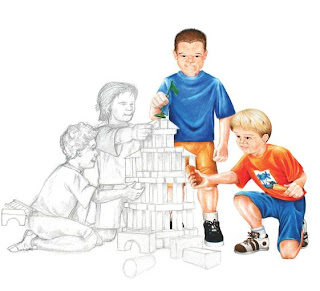Shared reading can help with language development
Newman (2004) also discusses how books can be used to help with language development. Based on her recommendations, here are some guidelines to help you with choosing and using appropriate books. I will use my book, Dave is Brave, to illustrate these as it was written and illustrated with these guidelines in mind.
1- Start with books that have clear and expressive pictures.
The reason for this is that children are engaged or their attention is grabbed by things that interest or attract them. Colourful and clear pictures mean that the child does not have to be concentrating on the book to have their eye attracted to it. Colour and clarity catch the “corner of their eye”, so to speak.
Pictures will also give you the opportunity to label items and ask questions to prompt language attempts. If the child is interested and engaged by the pictures, they are more likely to attempt to communicate about the book, whether it be through gesture or speech.
2- Use books that show characters doing everyday, familiar things.
Books about unfamiliar topics will mean that the child is not able to use their prior knowledge or experiences to identify appropriate words that they might be able to use. If the content is familiar, through the reading process the child will learn words that will help them function or participate in their everyday life activities.
You can also develop your own books by taking a sequence of photos of everyday routines. These books can be a great resource to help expand your child’s vocabulary.
Talk about the pictures, suggest things that the people in the pictures might be saying, ask your child to label objects or identify what the person is doing. If your child’s language is developing, start asking them less obvious questions such as how they think the people in the photo might be feeling.
The activity plans that are sold in the Dave is Brave pack provide you with questions that will not only help develop your child’s language, but also their emotional intelligence. That is, it will help them understand what is going on socially and emotionally, and will prompt them to use language that will help them express this in everyday, real life.
3- Simple stories with few words and lots of repetition are especially good.
As mentioned in a previous post, repetition is a great tool for helping children develop language through imitation and modelling. A book with rhythm and rhyme can also help prompt memory of sounds and phrases.
Dave is Brave is written with this in mind. For example, the text is written with the frequent repetition of the phrase, “Golly was a bully, but Dave was brave.” The text is also rhythmical:
“Golly was a bully when he didn’t act like a friend.”
When interacting with the book, Newman (2004) suggests firstly that you read the book normally, with natural expression in your voice.
Next, ask questions of increasing difficulty depending on the child’s level of language development. Educators often talk about the different levels of questioning as “here, hidden and in the head.”
For example, looking at this picture from Dave is Brave:
“here”: What did Dave say?
“hidden”: How do you think Dave is feeling?
“head”: Is Dave a boy or a girl?
Thirdly, there may be times whey you will need to paraphrase books to make sure that your child understands the language. This relates to your family or classroom language culture – the words you use to describe something may be quite different to those used in another family/classroom.
Finally, get the child to anticipate or guess what words comes next. And example of this is the cloze activity that is part of the listening games on the Dave is Brave music CD. What I do is pause to encourage the listener to say some of the repeated words for me. The rhyme also helps with this.
For example, “This is Dave. He is …..”
My final recommendations?










0 comments:
Post a Comment